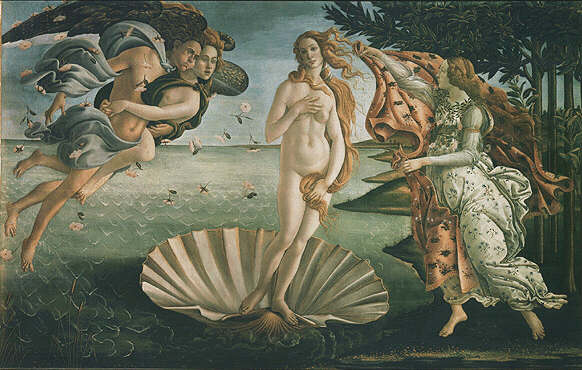Uffizi Gallery Private Tour

Uffizi Gallery Guided Tour with Private Guide
This tour represents un unforgettable experience visisting the world-wide famous Uffizi Gallery which houses the largest collection of paintings from Romanesque period to the 18th century.
Nowadays the Uffizi still accommodates famous masterpieces exhibited in chronological order.
Tour with private guide - Exclusive service!
Duration: about 3 hours
Availability: from Tuesday to Sunday. This tour is not available on the first Sunday of each month, Christmas and New year’s Eve.
Tour Starting time: from 8:30 am until 4:30 pm, the choice of the time is up to the customer. From June to September, this tour is also available on Tuesday night.
Language: English or any other language.
This tour lasts about 3 hours. The tour itinerary can be personalized according to any visitors’ special request.
The standard schedule includes all most important masterpieces on show, from Cimabue to Caravaggio’s paintings. The guide will also highlight the main features of the Uffizi palace and details about its fascinating history.
The Uffizi Gallery Tour Itinerary
The path starts from the great Romanesque paintings by Cimabue, heading on to the Gothic revolution of Giotto and following on with the decorative richness of the late-gothic art belonging to Gentile da Fabriano. Renaissance innovations are testified with works by Masaccio, Paolo Uccello, Piero della Francesca and Filippo Lippi, whilst the great season of Lorenzo il Magnifico is represented by Sandro Botticelli's masterpieces like “The Birth of Venus” and the “Allegory of Spring”. The exhibition carries on with paintings from Leonardo da Vinci and the only documented painting by Michelangelo, the “Doni Tondo”, before arriving to the acknowledged works by Raphael and Titian. A wide section hosts Caravaggio's “Bacchus” and “Medusa” as well as the works of the master's followers such as Artemisia Gentileschi. The museum's path ends with neoclassical paintings of the '700 as a prelude to modern art.
During your tour, the guide will also comment the architectural features of the magnificent Uffizi building projected by the architect Giorgio Vasari who started the construction of the great Uffizi palace in 1560 under the desire of Cosimo I de' Medici. The awesome building was meant to host thirteen magistracies. Construction of the top floor was ended in 1580 and was designed to host the Medici family's artwork collection.
"Birth of Venus" by Botticelli
There exists no documentation on the origins or the first owner of the Birth of Venus, which like Pallas and the Centaur was painted on canvas, a highly unusual support at the time.
 By the mid-16th century Vasari mentions it as being, along with the Primavera, in the suburban villa of Castello, the former property of Giovanni di Pierfrancesco de’ Medici and of his brother Lorenzo. Although the traditional option that Botticelli’s two most famous allegories formed part of the same series is no longer accepted, also considering that the dimensions and techniques of the two paintings are different, it is probable that the Venus, unlike the Primavera, hung from the beginning in the country villa of the two cousins of the Magnificent, having been commissioned by one of the two brothers. The title by which the painting is universally known comes from the last century, and is based on a faulty interpretation of the subject Venus Anadiomene (“arising from the sea”), a subject made famous by the painter Apelles in atiquity. In fact, Sandro Botticelli, inspired by the Metamorphosis of Ovid and perhaps by the verses of his friend Poliziano, is narrating a different episode from the legend of the Godness: her arrival at the Island of Kythera or perhaps Cyprus. Against a seascape rendered with almost metaphysical synthesis and abstraction, Venus stands naked on a huge shell, being pusher towards shore by the swell of the sea, helped by the breath of the winds Zephyrus and Aura, who gently embrace as roses fall from the sky. She is welcomed by a girl wearing a silken cloak embroidered with daisies and other flowers, probably one of the Hora, less likely one of the Three Graces. While the two figures on the left may be taken from the famous Tazza Farnese, now in the Naples Archaelogical Museum but then in the gem collection of Lorenzo the Magnificent, the pose of the main figure is inspired by the antique sculptural type, The Chaste Venus, well-known since Medieval times.
By the mid-16th century Vasari mentions it as being, along with the Primavera, in the suburban villa of Castello, the former property of Giovanni di Pierfrancesco de’ Medici and of his brother Lorenzo. Although the traditional option that Botticelli’s two most famous allegories formed part of the same series is no longer accepted, also considering that the dimensions and techniques of the two paintings are different, it is probable that the Venus, unlike the Primavera, hung from the beginning in the country villa of the two cousins of the Magnificent, having been commissioned by one of the two brothers. The title by which the painting is universally known comes from the last century, and is based on a faulty interpretation of the subject Venus Anadiomene (“arising from the sea”), a subject made famous by the painter Apelles in atiquity. In fact, Sandro Botticelli, inspired by the Metamorphosis of Ovid and perhaps by the verses of his friend Poliziano, is narrating a different episode from the legend of the Godness: her arrival at the Island of Kythera or perhaps Cyprus. Against a seascape rendered with almost metaphysical synthesis and abstraction, Venus stands naked on a huge shell, being pusher towards shore by the swell of the sea, helped by the breath of the winds Zephyrus and Aura, who gently embrace as roses fall from the sky. She is welcomed by a girl wearing a silken cloak embroidered with daisies and other flowers, probably one of the Hora, less likely one of the Three Graces. While the two figures on the left may be taken from the famous Tazza Farnese, now in the Naples Archaelogical Museum but then in the gem collection of Lorenzo the Magnificent, the pose of the main figure is inspired by the antique sculptural type, The Chaste Venus, well-known since Medieval times.
Regardless of its meaning, this work, like the Primavera, is representative of the most serene and graceful phase of Botticelli’s art, clearly linked to the neo-Platonic atmosphere of Lorenzo’s age. Once again complex philosophical ideas lie behind the meaning of the painting, which may symbolize the fusion of Spirit and Matter, the harmonious marriage of Idea and Nature, as explained by Ernst Gombrich. Instead of the brilliant, solid colors used for the Primavera, the Birth of Venus is painted with a mixture of diluted egg yolk and light tempera, giving it an extraordinary transparency similar to that of a fresco.
Our guides
Italy Travels tour guides staff is represented by licensed guides of great experience and high level of professionalism, competence and excellence on their job. All Italy Travels guides are authorized by the provincial administration of Florence and most of them are art historians and teachers in art subjects.
All private tours organized by Italy Travels always include pre-reserved museum tickets when museum tours are included in the tour itinerary. In this way visitors avoid waisting time waiting in line in front of museums ticket offices.












